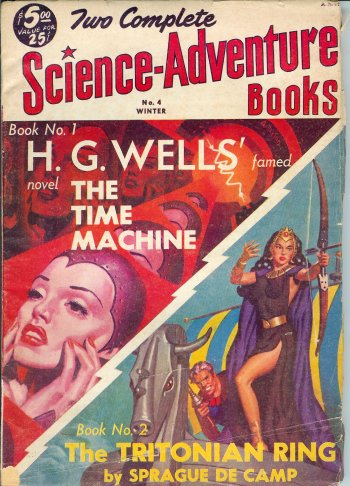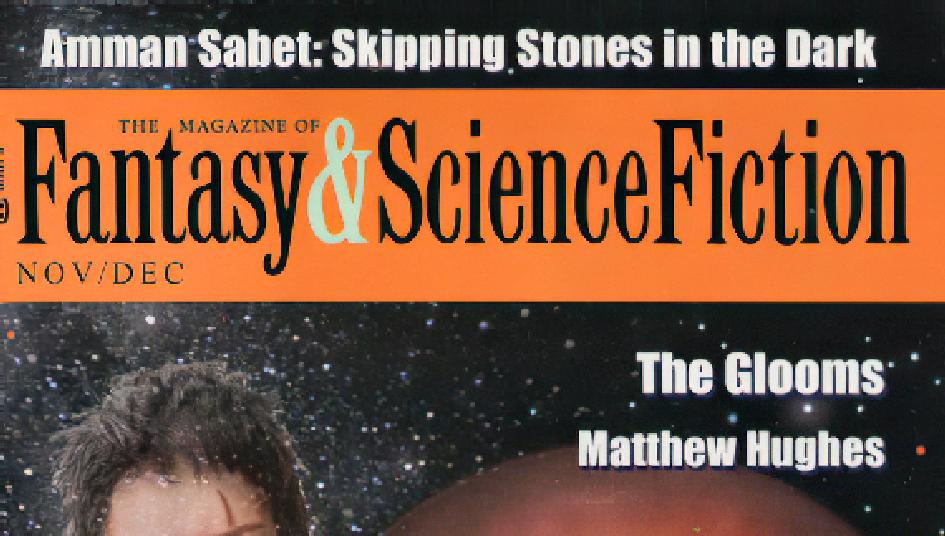 Two things happened in 1950. One: L. Sprague de Camp read his first Conan story. And two: L. Sprague de Camp would try to direct Sword & Sorcery down another track altogether. Those two don’t really make much sense. Didn’t L. Sprague de Camp become the editor/posthumous collaborator of Robert E. Howard?
Two things happened in 1950. One: L. Sprague de Camp read his first Conan story. And two: L. Sprague de Camp would try to direct Sword & Sorcery down another track altogether. Those two don’t really make much sense. Didn’t L. Sprague de Camp become the editor/posthumous collaborator of Robert E. Howard?
It went something like this: in 1950 Gnome Press released their first Conan title, the novel Hour of the Dragon as Conan the Conqueror. A review copy went to Fletcher Pratt, an author who had collaborated with L. Sprague de Camp on the Harold Shea stories back in Unknown in the 1940s. These novels spoofed classic myths with a hapless adventurer named Harold Shea. The Shea books were being reprinted by Gnome along with other Science Fiction titles. Pratt hated muscled-bound hero-types but thought Sprague might like it. It’s hard to believe but L. Sprague de Camp had missed the original Conan run in Weird Tales and was struck by the power of this novel. He was about to go down a road that would lead to decades of Conan editing and pastiching. But at the same time, he tried to take S&S on a new path. (We’ll come back to De Camp, Gnome Press and all things Conan, but first….)
 In 1951, de Camp penned the novel The Tritonian Ring and with it he tried to shape the future of Sword & Sorcery. To do this he fell back on the ideas of John W. Campbell (the same that shaped Norvell W. Page’s Wan Tengri novels), that Magic is just Science misunderstood. The novel first appeared in Two Complete Science Adventure Books (Winter 1951) then in hard cover in 1953. This sprawling, episodic novel stars Vakar of Lorsk, the second son of King Zhabutir and future heir to the throne. Vakar is sent on a quest to find the one thing the gods fear most for the Deities plan the destruction of Lorsk. Chapter by chapter Vakar visits all the different countries of the Pusadian map, encountering weird characters and monsters, a satyr woman with lusty tastes, evil sorcerers, and finally about halfway through the book discovers the secret, then goes in search of the Tritonian Ring, made from the metal of a meteorite. Vakar fails to get the ring so he seeks out the original stone from which the metal was taken and has a sword made from it. And with the only iron sword in the world he returns home to single-handedly stop the invading army with their Medusas, lizard creatures able to freeze people solid. In the end he wins out but loses the throne to his brother Kuros, but doesn’t care for he has always preferred to live with Queen Porfia and study philosophy in Ogugia anyway.
In 1951, de Camp penned the novel The Tritonian Ring and with it he tried to shape the future of Sword & Sorcery. To do this he fell back on the ideas of John W. Campbell (the same that shaped Norvell W. Page’s Wan Tengri novels), that Magic is just Science misunderstood. The novel first appeared in Two Complete Science Adventure Books (Winter 1951) then in hard cover in 1953. This sprawling, episodic novel stars Vakar of Lorsk, the second son of King Zhabutir and future heir to the throne. Vakar is sent on a quest to find the one thing the gods fear most for the Deities plan the destruction of Lorsk. Chapter by chapter Vakar visits all the different countries of the Pusadian map, encountering weird characters and monsters, a satyr woman with lusty tastes, evil sorcerers, and finally about halfway through the book discovers the secret, then goes in search of the Tritonian Ring, made from the metal of a meteorite. Vakar fails to get the ring so he seeks out the original stone from which the metal was taken and has a sword made from it. And with the only iron sword in the world he returns home to single-handedly stop the invading army with their Medusas, lizard creatures able to freeze people solid. In the end he wins out but loses the throne to his brother Kuros, but doesn’t care for he has always preferred to live with Queen Porfia and study philosophy in Ogugia anyway.
The tone of The Tritonian Ring is odd, especially in 1951. It is sexist but it isn’t. It is violent and cruel but it’s funny. It is satirical but isn’t a parody. What de Camp penned was a quest worthy of Odysseus, filled with a consistent universe, one that sees the end of Magic and the beginning of Science. His writing about sword fighting, ships, horsemanship and battle formations is faultless, having a wide knowledge of all these things from his historical non-fiction, but the whole thing feels more like Science Fiction than good Sword & Sorcery. It is almost an un-Fantasy. And that may have been the point. Life is cruel but also funny, people are weak but strong and Fantasy should sometimes be more realistic and less Howardian.
 De Camp continued the series off and on with “The Eye of Tandyla” (1951), “The Owl and the Ape” (1951), “The Hungry Hercynian” (1953), “The Stronger Spell” (1953), “Ka the Appalling” (1958), “The Rug and the Bull” (1974) and “The Stone of the Witch Queen” (1977). All contain magic and a little fighting but none comes close to The Tritonian Ring in scope. The last tales of Gezun of Lorsk are particularly tedious with Gezun’s weaknesses costing him his prize each time. The effect is meant to be humorous but makes them closer in spirit to Don Quixote than Beowulf. As examples of what Sword & Sorcery was supposed to become they are incongruent in collections like Flashing Swords #2 (1974) . De Camp would continue to write Fantasy in this style with his Novarian novels (The Goblin Tower (1968), The Clocks of Iraz (1971), The Fallible Fiend (1972), “The Emperor’s Fan” (1973), The Unbeheaded King (1983) and The Honorable Barbarian (1990) but he failed to turn the tide in this direction for most writers and fans, partly due to his own activities with Conan and Gnome Press.
De Camp continued the series off and on with “The Eye of Tandyla” (1951), “The Owl and the Ape” (1951), “The Hungry Hercynian” (1953), “The Stronger Spell” (1953), “Ka the Appalling” (1958), “The Rug and the Bull” (1974) and “The Stone of the Witch Queen” (1977). All contain magic and a little fighting but none comes close to The Tritonian Ring in scope. The last tales of Gezun of Lorsk are particularly tedious with Gezun’s weaknesses costing him his prize each time. The effect is meant to be humorous but makes them closer in spirit to Don Quixote than Beowulf. As examples of what Sword & Sorcery was supposed to become they are incongruent in collections like Flashing Swords #2 (1974) . De Camp would continue to write Fantasy in this style with his Novarian novels (The Goblin Tower (1968), The Clocks of Iraz (1971), The Fallible Fiend (1972), “The Emperor’s Fan” (1973), The Unbeheaded King (1983) and The Honorable Barbarian (1990) but he failed to turn the tide in this direction for most writers and fans, partly due to his own activities with Conan and Gnome Press.











Hi Mr. Thomas,
If you ever get really bored, go over to the REH Board and post a comment stating the L. Sprague DeCamp was the greatest thing that ever happen to Bob Howard.
Hilarity will ensue.
😉
Doug
p.s.
I love your “Clayton Astounding” collections!!